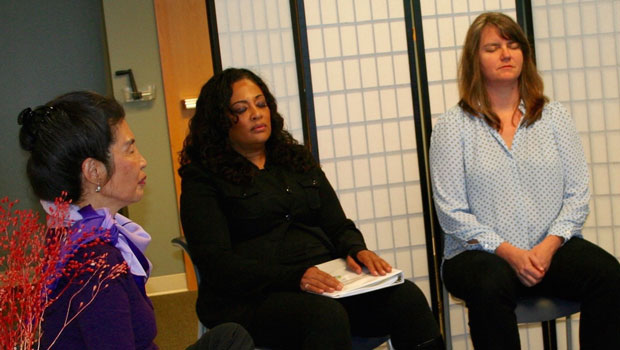Mindfulness meditation eases chronic low back pain

JAMA publishes research by Group Health researchers, comparing mindfulness, cognitive behavioral therapy, and usual care for back pain
SEATTLE—Meditation long has been practiced as a way to calm the mind, and possibly achieve enlightenment. Now, new research conducted by Group Health Research Institute shows that quieting the mind may be a non-drug alternative to help decrease chronic low back pain.
A team of researchers at Group Health Research Institute, a division of Group Health, explored alternatives to pain medication in treating low back pain, a chronic and costly condition that plagues eight in 10 Americans at some point in their lives.
Researchers compared a specific kind of meditation called mindfulness-based stress reduction (MBSR) along with cognitive behavioral therapy, a kind of talk therapy, to see if these interventions might alleviate pain.
The results were encouraging, said study leader Daniel Cherkin, PhD, a senior investigator at Group Health Research Institute.
“We’re constantly looking for new and innovative ways to help our patients,” Cherkin said. “The research suggests that training the brain to respond differently to pain signals may be more effective—and last longer—than traditional physical therapy and medication.”
Training in MBSR led to meaningful improvements in functioning and chronic low back pain at six months and one year in Mind-Body Approaches to Pain, a randomized controlled trial involving nearly 350 patients at Group Health.
The Journal of the American Medical Association published this trial as “Effects of Mindfulness-Based Stress Reduction vs Cognitive-Behavioral Therapy and Usual Care on Back Pain and Functional Limitations among Adults with Chronic Low Back Pain: A Randomized Clinical Trial” and an accompanying editorial: "Is It Time to Make Mind-Body Approaches Available for Chronic Low Back Pain?"
MBSR is becoming increasingly popular and available in the United States. It involves training in observing, acknowledging, and accepting thoughts and feelings including pain. The training also includes some easy yoga poses to help participants become more aware of their bodies.
“We are excited about these results, because chronic low back pain is such a common problem and can be disabling and difficult to treat,” Dr. Cherkin said. In recent years, he added, the United States has been spending more money on back pain treatments—with worse results in how much pain bothers people and interferes with their lives.
Randomized controlled trial
The trial enrolled 342 Group Health patients aged 20 to 70. Their low back pain had lasted at least three months and could not be attributed to a specific cause. The trial participants were randomly assigned to one of three groups. The first two groups received training in eight weekly two-hour group sessions in addition to whatever care they chose to seek independent of the study. One of these groups received training in MBSR and the other in cognitive behavioral therapy (CBT). The third group received only their usual care.
Compared to the group receiving usual care, participants in both the MBSR and CBT groups were significantly more likely to experience clinically meaningful (at least 30 percent) improvements from baseline in functional limitations and in self-reports of how much back pain bothered them. The proportion of participants with these improvements was similar, with no significant differences, between the mindfulness and CBT groups at each time point: one, two, and six months—and at one year—after enrolling in the study. Usual care is whatever patients would be doing for their back pain if they weren’t in the study, including medications and physical therapy—but not mindfulness meditation or cognitive behavioral therapy.
Mindfulness and CBT
Before this trial, other research had shown mindfulness helped back pain in older adults—but it had never been tested in young or middle-aged adults. CBT, which was developed to treat depression, also had been previously proven effective for back pain in a variety of age groups. CBT is training to help people reframe how they think about pain so that they can manage it more successfully and change their behaviors, such as lack of exercise, that contribute to continued pain.
“We are not saying ‘It’s all in your mind,’” Dr. Cherkin said. “Rather, as recent brain research has shown, the mind and the body are intimately intertwined, including in how they sense and respond to pain. Both mindfulness and CBT involve the brain as well as the body. We found that these approaches were as helpful for people with chronic back pain as are other effective treatments for back pain.” They also had longer-lasting benefits and were safer than many other treatment options.
“Our findings are important because they add to the growing evidence that pain and other forms of suffering involve the mind as well as the body,” he added. “Greater understanding and acceptance of the mind-body connection will provide patients and clinicians with new opportunities for improving the lives of persons with chronic back pain and other challenging conditions that are not always effectively managed with physical treatments alone.”
Next steps
“We want to see whether the effects of mindfulness and CBT persist for more than a year,” Dr. Cherkin said. “And we want to learn whether mindfulness and CBT affect people through the same or different processes. For example, do the benefits of mindfulness training result from increased mindfulness and acceptance of pain, whereas the benefits of CBT result from changes in pain beliefs and more effective use of pain coping strategies?”
The National Center for Complementary and Integrative Health of the National Institutes of Health supported this research (award number R01AT006226).
Dr. Cherkin’s coauthors are Karen Sherman, PhD, Andrea Cook, PhD, Melissa Anderson, MS, Rene Hawkes, and Kelly Hansen, of GHRI; Benjamin Balderson, PhD, a Group Health psychologist and GHRI researcher; and Judith Turner, PhD, of the University of Washington (UW) School of Medicine’s Departments of Psychiatry and Behavioral Sciences and Rehabilitation Medicine.
The authors also have these joint appointments: Dr. Cherkin in Health Services at the UW School of Public Health and in Family Medicine at the UW School of Medicine, Dr. Sherman in Epidemiology at the UW School of Public Health, and Dr. Cook in Biostatistics at the UW School of Public Health.
They have also shown that massage, acupuncture, and yoga can help ease back pain. You can read a blog post by him reflecting on his research to improve outcomes for people with back pain.
About Kaiser Permanente
Kaiser Permanente is committed to helping shape the future of health care. We are recognized as one of America’s leading health care providers and not-for-profit health plans. Founded in 1945, Kaiser Permanente has a mission to provide high-quality, affordable health care services and to improve the health of our members and the communities we serve. We currently serve more than 12.4 million members in eight states and the District of Columbia. Care for members and patients is focused on their total health and guided by their personal Permanente Medical Group physicians, specialists and team of caregivers. Our expert and caring medical teams are empowered and supported by industry-leading technology advances and tools for health promotion, disease prevention, state-of-the-art care delivery and world-class chronic disease management. Kaiser Permanente is dedicated to care innovations, clinical research, health education and the support of community health. For more information, go to: kp.org/share.
video
Mindfulness-Based Stress Reduction vs Cognitive Behavioral Therapy for Chronic Low Back Pain
(JAMA Network, 2:26)
healthy findings blog

A call for a more patient-centered approach to treating back pain
for immediate release
Media contact
For more on Kaiser Permanente Washington Health Research Institute news, please contact:
Bianca DiJulio
bianca.s.dijulio@kp.org
206-660-8333
After-hours media line: 206-448-4056



